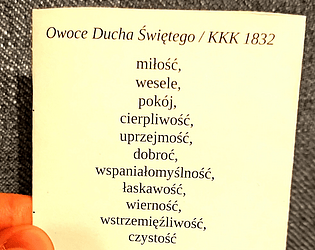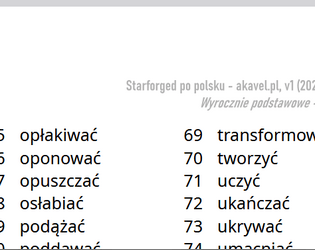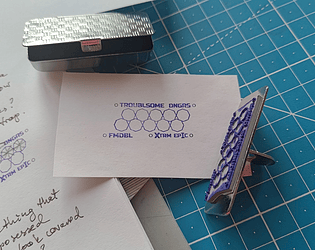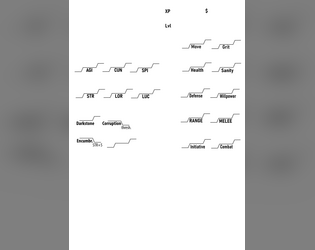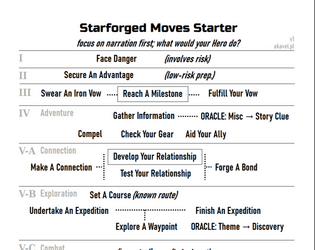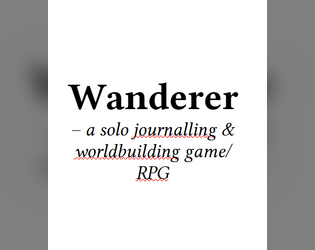Do you think it could make sense to retcon this version as something of a “Prequel” for the full KS version in the in-game world’s mythology? I see you’re already tweaking the rules for the “full” version, from what I just saw in the KS updates - but it seems to me this “Demo” game is substantial enough that it can be considered a worthwhile standalone thing. It feels to me like it could be fun to keep it available after the KS fulfills, and consider the hacking of Wotan as an “old tale” from “the old days” among the hackers of the “new” Card Drives.
akavel
Creator of
Recent community posts
Very minor: in the low-ink extra cards, the 2nd Alien’s white (“late”) version has their jaw slightly displaced 😂 honestly I’m not so surprised, trying to bite a misbehaving printer in anger can break even the fiercest Alien’s jaw 😁 especially when already tired by the constant fighting with those pesky crewmembers! (FWIW it’s visible already in the screenshot in the post above 🙂)
Thank you! So this sounds like I cannot use a Straight Killotine as a Flush Cache instead. Thanks for the clarification!
FWIW, as I wrote before, I have no idea really about poker; that’s why I have no slightest idea about its inherent assumptions. I did not see a warning in the game’s description that “you must know poker rules to be able to play this game”, so I did not make such assumption :) Part of me asking those questions - other than sincerely just not knowing the answers and trying to clarify and understand how I could play it - is to also try and show to you that there are people like me to whom those poker parts are the furthest from obvious, so you might consider including some such basic explanations somewhere in the rules, if at least in the Full Blown Kickstarter Version, to make sure people with zero poker knowledge can still enjoy this game :)
Thanks for making the video, it gave me some better understanding of a few things I didn’t wrap my head around yet after just reading the rules. For anyone else interested, the video is at: https://youtu.be/VTBr8QIN-6U
Ohhh, ok, thanks, that’s very different from what I understood! I read the following guideline in the booklet, and I assumed I need to follow it: “Aces have a value of either 1 or 11, face cards count as value 10 outside of a straight” - that face cards count as 10 except in programs named “Straight”.
As to the Straight Killotine vs. Flush Cache, I wanted to ask a different question actually, I now see I didn’t phrase it clearly enough: what I want to ask, if I have cards for a Straight Killotine, can I instead play them as a Flush Cache? i.e., let’s say I have 2+3+4+5+6 of one suit, so I could play them as Straight Killotine; but do I have the choice to instead treat and play them as Flush Cache? Or is it required for Flush Cache that the ranks must not be fully sequential, that I can only play a Flush Cache if the cards do not form an unbroken sequence?
EDIT: Ahh, and also then, for a “3 SEQUENCE” Exploit, can faces be used here, or only “number” cards? and if faces can be used, they count as a “10” each, yes? or again as ranks?
Thank you! So, IIUC, this means as a result I might sometimes have more than 7 cards in hand, is that right?
Also, to clarify the ranks/values:
- in “Pairing”, “Thrill…” (Three), “Full Pairing” (Four), and “Full Shutdown”, each of the “faces” counts as 10, so I can for example treat a Q+K as a “Pairing”, and for example Q+Q+K+J as a “Full Pairing”, yes? However, I can not treat Q+Q+K+K as “Double Pairing”, because again each of them counts as 10, and “Double Pairing” requires pairs of different values/ranks, right?
- if I have Q+Q+Q+K+K, I cannot treat them as “Full Shutdown”, because they all have value 10, while they should have different values, yes? or can I?
- for checking “Straight Circuit” and “Straight Killotine”, the values of faces & aces are interpreted as: J=11, Q=12, K=13, A=14, yes?
- if I have a “Straight Killotine” (Straight Flush), can I also play it as “Flush Cache” (Flush), or not? in somewhat other words, to play “Flush Cache”, can I assume that I can ignore values/ranks of cards, and just check if I have 5 cards of the same suit, regardless of their values/ranks? If not, then does the faces=10, ace=1/11 valuation apply (making faces disadvantageous for “Flush Cache”), or the: J=11, Q=12, K=13, A=14 one?
- “Corpo Keys” = A+K+Q+J+10, of the same suit, yes?
I never played Poker, so the “Programs” were very confusing to me, I was not sure how to do them. Only when I saw the name “Full House” in there, I started having a suspicion: “hey, that sounds like a thing that cards people say; maybe it’s some kind of a specific thing in card games?” I’d be grateful if you could add explanations of those things in the booklet somewhere for people like me, who never in their life encountered those names - and even more so in English.
For others like me, here’s a list of those, as far as I could understand from Wikipedia - I may be wrong though:
(note: “rank” in those seems to mean the card’s “value” if it is 2-10 card; while for non-number cards, based on Card Drives booklet, it seems to be A=(1 or 11) and J/Q/K=10, except for Straight, where presumably “traditional” Poker values would apply, which seem to be: J=11, Q=12, K=13, A=14)
- PAIRING (Pair) = a hand containing two cards with the same rank (for example, two “2”s), and the remaining cards having different values
- DOUBLE PAIRING (Two Pair) = a hand containing two cards with the same rank, another two cards with another same rank, and the remaining cards having different ranks
- THRILL KILL SHUT DOWN (Three of a Kind) = a hand containing three cards with the same rank, and the remaining cards having other ranks
- STRAIGHT CIRCUIT (Straight) = a hand containing five cards with sequential ranks (e.g. 2,3,4,5,6, or 3,4,5,6,7, etc), with not all the same suits (because then it would be a Straight Flush, I think?) - note: “traditional” card values seem to apply in Straight, which would presumably mean: J=11, Q=12, K=13, A=14
- FLUSH CACHE (Flush) = a hand containing five cards of the same suit, not all being sequentially ranked (because then it would be a Straight Flush, I think?) - note: I’m not sure whether the “traditional” or “Card Drives booklet” values apply here for non-number cards 🤔
- FULL SHUTDOWN (Full House) = a hand containing three cards of one same rank, and two cards of another same rank (e.g. 3,3,3,2,2)
- STRAIGHT KILLOTINE (Straight Flush) = a hand containing five cards of the same suit, in sequential order of ranks - note: “traditional” card values seem to apply in Straight, which would presumably mean: J=11, Q=12, K=13, A=14
- FULL PAIRING (Four of a Kind) = a hand containing four cards of the same rank, plus one card of a different rank
- CORPO KEYS (Royal Flush) = A,K,Q,J,10, of the same suit, I think?
Based on the above, I also assume probably to “play a program”, one has to use a hand of 5 cards always? though I’m not really sure about it - maybe e.g. for a Pair it’s enough to use/discard 2 cards? I’m even more confused with e.g. PAIRING which says “Draw 3 cards”, but then right above it is written: “After playing a program, you refill your hand to 7 cards.” - so how many cards am I expected to discard, and how many to have in my hand after playing the Program? 🤔
Somebody already created a BGG entry FYI: https://bgg.cc/boardgame/459747/card-drives
Ahh, right, a page is actually two-sided, so something can be printed on the other side too 🤦 eh lol 😂
FWIW, I since created my own variant with “embedded OLE Objects”, because I wanted to insert a table, and apparently in LibreOffice tables can’t be inserted in a “Textbox”, whereas a “Text Frame” allows inserting tables, but doesn’t allow 180º rotation 🤦 in the end, I inserted an embedded LibreOffice Calc sheet in a LibreOffice Draw page 🤯 I’m surprised how powerful LibreOffice can get sometimes. I haven’t published the result anywhere yet, but once I do, I can share a link if you’d be curious.
No worries! :D oh cool, I’d be happy to try the Excel file - though I don’t have Excel… does it maybe work in Google Sheets as well? or OpenOffice/LibreOffice? anyway - I’m not aware of DMs on itch, but I see you have an account on BGG mentioned on your page - I’ll try to DM you there right now, we can try to talk further there. Just in case, my account there has exactly the same name as here on itch.
I’d like to ask you a few questions about “feature expansions” and tweaks to this:
-
I’d be interested in a variant “tailored” for the Ironsworn RPG. That game’s main (and only really) roll is a “2d10 vs. 1d6”. I’m thinking it could be maybe possible to put a d10 table on one side of a DiceFold “spread”, and a d6 table on the other side, and then thus make it possible to “roll simultaneously” on both sides of the spread by slapping a single “Bard business card” over such a spread. Would you maybe be open to doing such a mod? If you don’t care enough, could you maybe possibly at least give some suggestions (if you have any) on how one should permutate the numbers on a page, if I wanted to try and create such a variant myself?
-
Another thought I got, was that I’d love if there was a variant of DiceFold for “a standard deck of cards”. There are some RPGs using “a standard deck of cards” for their randomization (one example is the Glide RPG). I personally really dislike that mechanic - I find it much more cumbersome to carry compared to dice - but I your DiceFold idea got me thinking, that maybe it’d be much easier to use for me in that format! I.e., maybe a set of cards could also be printed on a DiceFold page in randomized order, and then after randomly picking one, I could cross it out to simulate “discarding it”. After I “used up” the whole deck, I could have another DiceFold printed, and use those again; or, a single DiceFold could maybe have a few “decks” printed on subsequent pages. I’m still not sure how best to then solve the situation when a huge number of results is crossed out; maybe I could just go right-and-down (or some other “path” could be drawn, like a spiral, to guide me) till the first non-crossed-out one? Also I know it wouldn’t be able to allow all fancy things that can be done with a deck of cards - and some games can use those - but I believe many RPGs use the cards purely for randomization, with zero fancy extra stuff that can be done with cards…
-
What would you think to maybe draw the “table grid” with “cells” for the numbers, so that in case of ambiguity, it could be maybe easier to see on which side of those lines the “Bard” picker landed, and thus on which number? I saw some review (maybe on BGG?) complain about ambiguity, and this made me think of introducing lines inbetween the numbers to maybe make it easier (I think Gloomholdin’ uses lines in its variant of this idea?)
-
One more thought I got, is that there’s also a “PocketFold” format, that is kinda similar but has some pros & cons compared to “PocketMod”; and one idea came to me, that maybe with a PocketFold, the “Bard card” feature could actually be integrated into the PocketFold itself? by “folding” a partially opened PocketFold at a “random” angle onto the other side… I’m probably not explaining it very clearly though, sorry… 😅
What are your thoughts on those ideas?
EDIT: Hm, I just found that 1 & 2 of the above seems apparently already possible on the pocketmod website - although in somewhat crappy quality IMO. But I’ll try to test it this way maybe. EDIT 2: Uh; “2” is still broken on pocketmod website, because they repeat the same cards multiple times - there should be just a permutation of 52 results (+/- jokers), not repeats… eh, but at least I can try the idea 1…
EDIT 3: The idea number 4 doesn’t seem to really work well in practice, FWIW. That said, a 2nd separate pocketmod/pocketfold booklet could probably be used as a “Bard card” as well, just in case.
Whoah, I love the stories - and I’m having some chills reading them, super cool! 😄 Thank you for sharing!! Glimpses of an incredible world - exactly how the system worked for me - I’m super happy it also worked for you ☺️
EDIT: Ah; also, if you like gathering and mixing ingredients, and are interested in various Solo RPGs - I never played those, but I would suspect “Apothecaria” and “Koriko, the magical year” might possibly have some stuff like that. Also, otherwise, if you’re out on a hunt in general, my personal top by a mile favorite TTRPG for the time being is “Ironsworn: Starforged”… if looking for a more cosy and social variant, I heard people say good words about “Iron Valley”…
Thank you for the good words! I love to hear that you enjoy it 😊💖
The inspiration for the motifs table was triggered by (and named after, to honor this legacy) a somewhat similar one in Calypso (by katamoiran). It’s quite a different game, but if you liked this part, you might also possibly be interested to take a look at that one! 🙃 No promises though 😜 just sharing 🙂
(FWIW, just in case you might be open to sharing the stories you built, I’d totally love to read them - but also it’s absolutely not required! I super-highly respect private soloing - it needs to be the default mode of play, and is how I myself strongly prefer to play.)
Yes, I saw them - but the one in the linked video at the specific time offset seems to be yet another one, and I wonder where it comes from! The difference is, it has cool kinds of various “shapes” that differ for different stats - for example, Water has a shape of a drop of liquid, Stamina has a shape for a heart, etc. But neither of the 2 sheets in Demo have this - and I would find it really cool to use such kind…
Hi! In the playthrough on youtube by Lone Adventurer, a Character Card is visible with pretty “shapes” for Stamina, Fuel, etc. (https://youtu.be/p8r4TvsVewA?t=935) - is this Character Card available somewhere for download? Of the ones I see on this page, neither seems to have those pretty shapes :( am I overlooking something? 🤔
Also wanted to ask the same question, so thank you for clarifying this here! I admit it is still always confusing to me whenver I roll it, because I’m not sure whether it means a place on a planet, in a settlement, or in a starship; but I do seem to figure a way out of it eventually, either my brain gives me some delicate hint as to the answer, or I roll again to get an answer to that question.
If you ever think to make an updated version of the book, it’d be super cool if you included the Starforged Reference Guide’s page in those oracles.
As I’m already writing, I wanted to say I utterly love your expansion, and am crazy grateful to you for creating and sharing it. Especially the “Episodic Adventures” formula significantly helped me to actually manage to start having fun with Starforged, and to unlock a way to let me play it. The vanilla I:S was exhausting and overwhelming to me through the worldbuilding requirements, plus its Inciting Incident oracles didn’t work for me. Your approach helped me reach an attitude somewhere between a “TV series” and “Conan the Barbarian” novels - short episodes, where I allow myself to have discontinuities and incoherence and dumb shortcuts with impunity, and also just discard an episode half-way if I feel I’m losing the joy, just bootstrapping a new episode right away from scratch. Thank you, thank you, thank you!
Super interesting idea, thank you! And this seems to align nicely with the vague general feeling I had of a direction where things seemed to want to be going! Though I admit that personally I find it a bit difficult to wrap my head around in this way; but maybe that’s a time when an actual playthrough attempt at all of that could give some more clarity 😅
Hi! I wanted to say thank you for sharing Calypso; and that it became an inspiration for me to create a small journaling/worldbuilding game/rpg for myself. In case you’re interested to take a look, I shared it for free at: https://akavel.itch.io/wanderer All the best to you, and I love your games as pieces of art, they seem to keep being enchanting, seducing, and inspiring to me!
I discovered Cyberforged very recently, and I find especially its oracles absolutely amazing for the genre. Thank you so much for creating them, and putting so much of your experience and work into this expansion!!!
As a side note, browsing the PDF today I wondered: is there a chance you might be able to give the document an “embedded table of contents”? Currently, when I use a PDF reader app to open the ToC/structure of the document, it only shows me a list of page numbers (“Page 1”, “Page 2”, …). It would be really cool if I could browse the titles of the chapters and sections there instead - e.g. for quick jumping into the Oracles, or the Map-Making stuff, etc. On the other hand, a “regular” ToC in the text of the PDF would also be super helpful, especially if I were to print this awesume supplement, for screen-less use.
Anyway - that’s only some wishes; what you did here is already great, even if you never address them, and I suspect you may have some more important things in your life now, so I wish you all the best in them first of all!
Edit:
I actually ended up adding the Fate moves into the diagram; thanks for the suggestion and inspiration! I put Ask The Oracle in new “Phase 0”, and kinda emphasized parts of Pay The Price in “Phase VI Suffer” a bit more.
Original reply:
As to Pay The Price, as far as I understand it’s referenced from other Moves, so I assumed it doesn’t need a special entry, because it’ll be found through those other Moves. I also mention it near the Suffer Moves section’s title. Does one ever use Pay The Price in some situation other than when explicitly asked so by an outcome of another move? 🤔
As to Ask The Oracle, to me it seems mostly obvious; do you think of an argument that might support adding it somewhere in the diagram for some specific reason? Do you think it is not so obvious?
Notably, I also skipped Legacy Moves and Threshold Moves, as I feel they’re very rarely used and as such don’t need to be on a starter diagram.
On the other hand, recently I’m starting to wonder if I should try and include the Scene Challenges Moves 🤔
I love how this is narratively driven and lightweight, and yet still flavorful. I was especially amazed and impressed by the brilliant idea of spell effect Oracles - so nonobvious, and yet it makes so much sense now that I saw it. I find this supplement a perfect match for the Ironsworn series of games. And then also beautifully typeset, and shared as PWYW, to top it all… what a gem, thank you!
Hi! Starting with a potentially easy editorial issue: in the final “Playing Bladesworn” examples chapter, I noticed three sections with a lot of repetition, that seem accidentally mixed up to me. In particular, I mean pages 35-37, sections “Making it to the Ruins”, “Exploration”, and “Exploring the Ruins”. The middle one (“Exploration”) reads to me like a weird, confusing and unplanned mix between the two others - most notably, it contains many repeated sentences from the first one (“Making it to the Ruins”). Most glaringly, the whole bullet point of: “Set a clock for the wilderness’s dangers…” appears copied verbatim. And, to me at least, it seems out of place in an “Exploration” section. On the other hand, I don’t really understand what’s the difference between “Exploration” vs. “Exploring the Ruins”. Another example, seemingly hinting that this is an editorial error, is the final sentence of “Exploration”: “Let’s start a six-segment tension clock (from Starforged) for our pursuit” - exactly such a clock was already presented at the end of the previous section (“Making it to the Ruins”), while it’s not imaged in the middle section even though it’s mentioned there, as quoted. Thus, I assume this situation is some accident of editing/growing the text of the book; did you maybe mean to cut out the whole “Exploration” section before publishing? Or incorporate some parts of it into the neighboring sections?
Other than that, expanding on my initial notes on reddit, I now re-read the book with some more attention (compared to my initial half-awake skim). I really love the whole “four things” framework to approaching “Face Danger”. It feels surprisingly evocative and immersive to me vs. being distracted by the looming choice of a Move in base IS:SF. In a way, I think I’d like if one day I might maybe manage to marry the two, so as to be able to start immersed in your “Four Steps Framework”, then after completing it, maybe pick a Move from IS:SF and get its mechanical resolution. But, I digress. Just wanted to repeat, that for now, this is the part that captured me the most, and which I’m especially grateful to you for, and for writing and sharing it!
On the other hand, although they seem interesting to me, and feel like there’s “something” to them, for now I admit to being confused and unclear around the Scale-Quality-Potency elements. I mean, with the examples given, I seem to understand the aspects they’re trying to capture (overwhelmed/overwhelming size; better tools/skills; narrowly specific boost/advantage). However, what I don’t seem to understand, is how - after making the analysis - should they affect my gameplay/narration (apart from the single explicitly stated special case of increased/decreased progress ticks). Those elements seem vaguely mentioned in some (not even all, I think?) of the examples in the final chapter, but I still can’t seem to grasp how using them to dissect the scene actually influences the game. Would you maybe consider trying to expand on that aspect? Do you think it could make sense to e.g. take one (or more?) example Move resolutions, and speculatively elaborate on how each of the three dials (Scale-Quality-Potency) could narratively differ in that particular situation, and how would that then impact the gameplay/mechanics/narrative? (Ideally, in a way different than just a dry mechanical increase/decrease of ticks on a Progress clock. I assume those are still primarily intended as narrative tools; or not?)
Thank you!
Cool, I’m super happy it managed to give you some fun! :D thanks for sharing and leaving this comment! :D 💖
I’m really honored and curious what made you persevere and give it a second try, and not just ditch it, if you found the first reading to be a tough one 😅 I highly doubt if I myself would be so patient and generous in your place, so thank you 😅
Also, do you maybe have any thoughts what I could try to do to make the rules easier to swallow? 🤔
I would be honored!!
Once you do it, would you be so kind and let me know? I’d love to be pinged about it, so that I can either link to your account, or do it and also re-publish a copy of it here - totally depending on which you prefer and/or you think is better!
(And, just to make sure you don’t miss it, please mark your translation as licensed CC BY-SA 4.0 as well - as far as I understand that’s how the license terms need to be propagated.)
I would be honored!!
Is there a way you would prefer, and/or you think is better? Regardless, I would love to link to your account once it is done (in any case, whether a copy gets published here or only on your account).
(And, just to make sure you don’t miss it, please mark it as licensed CC BY-SA 4.0 as well - as far as I understand that’s how the license terms need to be propagated.)
Thank you for your kind words, and greetings to you from Poland as well! 🥰


